2019 Performing Arts Market in Seoul(PAMS)
Delegates Round-Table Talks (1)
‘Contemporary dance Platform; United Kingdom, Israel, Italy, Germany (1)’
Introduction
Ahram Gwak (Team Leader / Korea National Contemporary Dance Company)
As always, I’m so busy in October.
Performing arts markets, which had been crowded for a certain period of time, became quiet one by one. A variety of their programs led their participants to invest their time and money but they were ultimately reduced to networking events, rarely generating concrete results. Under these circumstances, many experts would have analyzed the cause of the problem and they would have made every effort to come up with better alternatives or solutions. Performing companies have also strived to think of how to perform on the global scene and how to go global in a safe, fast and cost-efficient way. Now, we conclude that our problem is not about distribution channels but about content itself. In other words, we are facing a limit to the production of creative performances.
Considering dance alone, it is not very difficult to select choreographers who make their first great attempts of 15 to 20 minutes. In fact, they already drew attention a couple of times at festivals and theaters in Europe and some of them also made meaningful achievements along with high expectations. The problem is their next step. It is relatively hard to find choreographers who build on their first successful attempts to make high-quality performances of more than 30 minutes or an hour. There may be diverse reasons for this. It could be the choreographers’ lack of capacity or the production environment that hasn’t improved for years. It could also be the general atmosphere of the dance scene that evaluates and analyzes performances on the basis of fixed trends and criteria.
It is amid such great concerns and problems that I started this busy month of October. There were works to sell, choreographers to collaborate with as well as artists and presenters to meet. I met with people in the dance scene gathered together for the market. Talking to them, I felt both empathy and curiosity. Believing that they would share the same concerns and problems, I also wanted to find out about how they are working in the dance scene because their backgrounds and policies are different. What dances are we watching? What dances are we making? How are we presenting dances?
2019 PAMS Round-Table Talk with Delegates in the Dance Scene (October 9, 2019 / Café Jang)
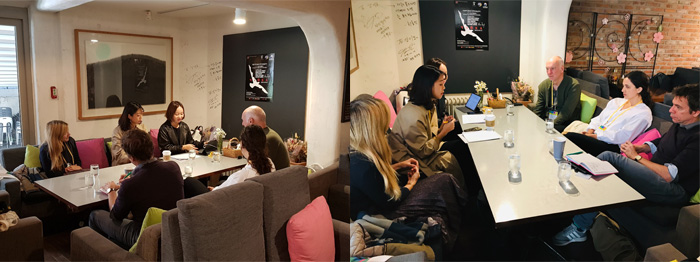
2019 PAMS Delegates Round-Table Talks ⓒKAMS
Moderator: Ahram Gwak (Team Leader / Korea National Contemporary Dance Company)
Translator: Hoyeon Kim (Intern / Korea National Contemporary Dance Company)
Participants (In alphabetical order)
Cristina Carlini (Italy / Marche Teatro, Inteatro Festival / International Project Manager)
Eddie Nixon (United Kingdom / The Place / Artistic Director)
Eiv Kristal (Israel / Machol Shalem Dance House ( MASH ) / Project Manager)
Walter Heun (Germany / Joint Adventures / Artistic Director)
Ahram Gwak: Thank you for coming early in the morning. It is already the third day of the Performing Arts Market in Seoul. Are you coping with your jet lag? I hope you are doing well.
Today, we have experts from the UK, Italy, Israel and Germany who produce dance, support and nurture dancers and run dance platforms. You would probably have different policies, backgrounds and conditions. Please share with us how you are running your dance programs, what your country’s contemporary dance environment looks like and how trends of creation and distribution are changing.
To begin with, I have two common questions or problems to talk about. I have worked at a dance festival for twelve years. For the last four or five years of this career, I focused on successfully helping Korean dancers go global. I’m now working on production. As in the past, it seems to be more and more difficult to find the right answer. What dances do we need to produce and distribute today? How could we define “contemporariness”? In the same vein, what do our contemporary dancers need? Please tell us about what you think.
Eddie Nixon (United Kingdom / The Place / Artistic Director): Located in London, The Place was founded 50 years ago. It would be one of the oldest contemporary dance institutions. The Place has gone through many changes throughout its long history but I’ll focus on what we do today. This year, we came up with a slogan called “Dancing for Life” after reflecting on the identity of our institution. First of all, the slogan shows our shared belief that the more we dance, the better this world will be. Second, it also means that The Place is open to everyone. Regardless of your age, origin and physical limits, you can participate in The Place’s programs in many different ways. It is very important for the institution to move forward on the basis of this concept. The Place has a variety of programs but to summarize, we have a dance school for about 240 students. We also provide a community program for about 1,000 participants and we present about 150 performances annually. We also help creators present their performances. Some of the performances are produced and distributed directly by The Place.
To answer your first question about what a good dance could be, I would like to share a talk with an American author based in London about “what contemporariness is.” I met with the author to post an article on my blog. We ended up concluding that it is undefinable but we talked about many different things on that occasion. Our first question was if “a good work” is made by its creator or by the audience watching it. The author had a workshop on the text of Shakespeare’s Othello with Ethiopian children. He says that the children, who didn’t know that the work had been written about 400 years ago, regarded it as very meaningful and contemporary. He also added that such an experience with the kids was more “contemporary” than any of his work. Today, artistic contemporariness isn’t limited to a work itself but what is important is how its theme is shared in the world. However radical creators’ themes may be, if they are dealt with only in artists’ room, could we call it contemporary? So what is vital to discussing contemporariness would be how a work is shared by whom and whom it stimulates to which degree.
The other day, I watched a play at the Edinburgh Festival Fringe. The play was written by Travis Alabanza, a transgender writer known as one of today’s major young authors in the UK. The play depicts Alabanza’s experience of becoming a victim of violence on the street in London. It was a great performance. What was interesting to me was the fact that the writer raises awareness of social issues by sharing a personal experience. There may be diverse ways to discuss such issues but Alabanza chose to bring the personal story to the theater and to the stage to denounce the audience as members of society. The performance generally feels witty and warm but at the same time, it makes the audience somewhat guilty. Such a feeling was very powerful. I believe that this play is contemporary because of its way of communicating with the audience by raising contemporary issues.
I’ll now try to answer your second question. When we collaborate with creators, we follow their ideas. It is true that we sometimes suggest certain themes. For example, we ask them to produce a performance for children. But after the suggestion, we just provide them with an environment that could help them make high-quality performances. It depends on our budget, space and time we could allocate to creators. It is also important to have meaningful discussions with creators. As an institution, we give them proper feedback so that they can look back on what they have done. To make it happen, I’m convinced that it is important to build a relationship based on trust between a creator and institution (or person in charge of the institution), even if it is the most difficult thing.
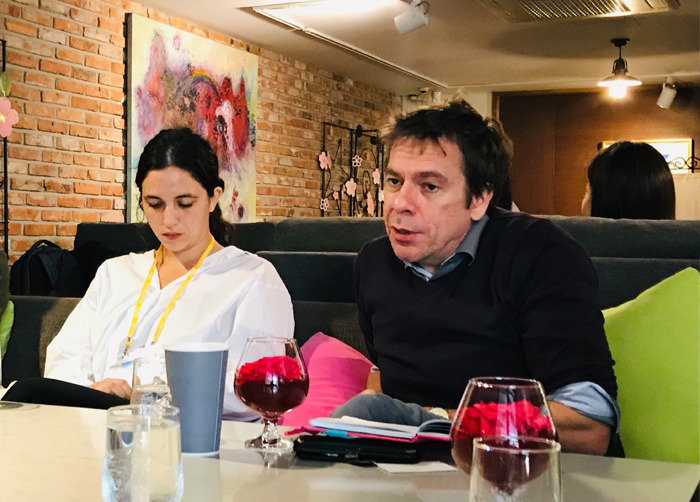
2019 PAMS Delegates Round-Table Talks / Eddie Nixon (United Kingdom / The Place / Artistic Director) ⓒKAMS
Ahram Gwak: Thank you for your answers. Let us discuss later on how we could build such relationships of trust and what specific process we need to follow. Now, I would like to ask Eive from the Machol Shalem Dance House (MASH). You attended International Exposure in Israel for two consecutive years in 2014 and 2015. On these occasions, you watched numerous works by unique and smart Israeli choreographers. I personally like Israeli dancers and they do have great competitiveness on the global scene. First of all, could you briefly introduce MASH? What does it do?
Eiv Kristal (Israel / Machol Shalem Dance House ( MASH ) / Project Manager): Before introducing MASH, I think I need to first explain what it means to make a performance in Jerusalem. In fact, Jerusalem is a very complicated and complex city. On one hand, the city has a ceaseless conflict over people’s beliefs. To be more specific, the conflict is between those who regard the city as a religious symbol and others who think it is just their living space unrelated to religion. Consequently, Jerusalem is a very political place where people are divided. If you live in the city, you will definitely feel such complexity. On the other hand, Jerusalem is a very interesting cultural hub. It has six or seven large art schools. Some of the schools are experimental and alternative with a history of 20 to 30 years. The students studying here form a very small and intimate community. They also collaborate with a variety of genres.
In short, Jerusalem is a city characterized by a complicated and tough political reality and at the same time, by cultural richness and experimentalism. Against this backdrop, MASH keeps thinking about how it could help artists work freely and how it could lead their works to meet Jerusalem’s audience. Indeed, all theaters and festivals in the city inevitably share the same concerns over the local audience. MASH supports creators and presents their performances. The House mostly supports choreographers from Jerusalem but it also carries out other projects simultaneously. We currently present a performance by choreographers working on tradition and religion and trans-traditional female dancers. The performance is a special case because it can only be staged for female audiences for religious reasons. We also organize the Jerusalem International Dance Week. On that occasion, only Israeli choreographers are given a chance to present their performances. During the same period, there is also an international choreographic competition in which young choreographers participate.
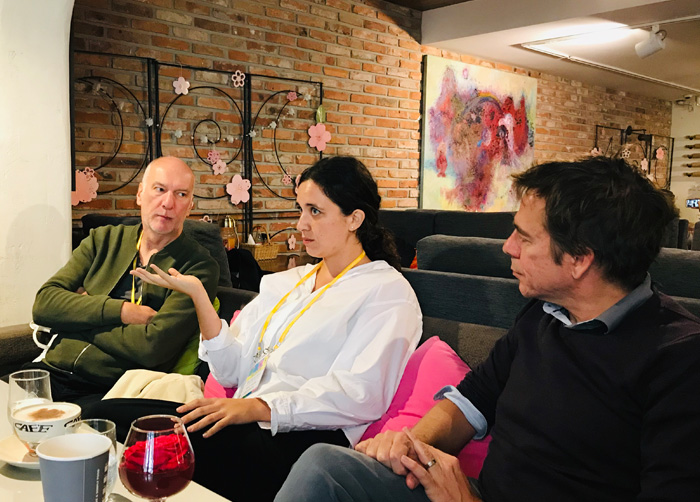
2019 PAMS Delegates Round-Table Talks /
Eiv Kristal (Israel / Machol Shalem Dance House(MASH) / Project Manager) ⓒKAMS
Cristina Carlini (Italy / Marche Teatro, Inteatro Festival / International Project Manager): Marche Teatro is a public theater located in Italy’s central area of Marche. The theater does diverse activities including production and invitation. It also has a program supporting young choreographers. Marche Teatro focuses on international cooperation programs. This is something special considering the fact that Italy lacks government support for the arts and culture compared to other countries. Throughout its history, the theater has actively engaged in international cooperation. In particular, it has organized a contemporary performing arts festival called Inteatro in the suburban area since 1977. The festival has served as a basis for the theater’s international cooperation. The theater also has a space called Villanapi which was made by renovating an abbey. In this space, the theater runs projects supporting and nurturing artists creating works. Meanwhile, the theater actively runs the July Festival. This festival has become a center of contemporary dance. That may be because dance is a genre that facilitates international cooperation.
We also share Ahram’s concerns. We have also kept thinking about what it means to create a good dance performance and how to do so.
In a recent press conference, the artistic director of Marche Teatro said that to see a big and beautiful flower, we need to sow as many seeds as possible. Production of a high-quality work doesn’t happen all the time and there is no clear recipe for this. So it is important for more artists to “have more opportunities” so that they can work professionally. As Eddie mentioned, I also agree that we need support in terms of finance, space and time. That is because artists particularly need a great amount of time and proper support.
Our residency program requires artists to reveal their work after a certain period of time. Creators are all different in terms of their focus points so they give presentations in a variety of ways. At that time, the theater’s entire staff participates to share different views. For example, I’m in charge of international exchange so I let artists know how much potential their work has as an international project, at the very beginning of creation. I also keep telling them that their work is a long haul and that they need to consider a great number of possibilities at the early stage of production. Based on such efforts, young choreographers in Marche has achieved remarkable growth recently. What makes me proud is the fact that the theater effectively introduces such young choreographers at its festival. In particular, many of our contemporary dancers are active on the global scene.
Ahram Gwak: What about the New Italian Dance Platform held every two years?
Cristina:The New Italian Dance Platform (NID Platform) is organized every time by a different local area and institution. It is one of the few events for which the Italian government provides support as part of international cooperation. Maybe because dance is a very small genre of the performing arts so it would have been an easy choice for the government to make. But still, the support is very limited. Even if we invite major international experts, it is difficult to start concrete projects due to the lack of government support. That is why institutions like ours are taking the lead. Through cooperation among festivals in Italy, we support projects like ‘Crossing the sea with Asia’ to introduce domestic artists globally and to start international cooperation. In fact, different government agencies are involved in political and bureaucratic problems so it is really tough for those engaging in cultural cooperation with other countries to benefit from government subsidy.
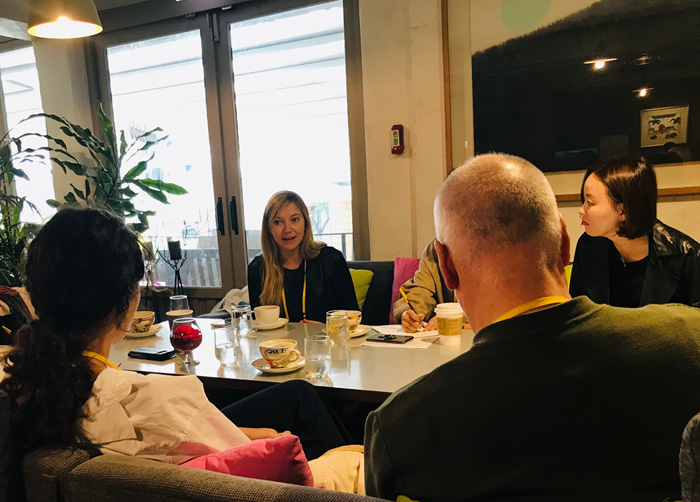
2019 PAMS Delegates Round-Table Talks /
Cristina Carlini (Italy / Marche Teatro, Inteatro Festival / International Project Manager) ⓒKAMS
Eddie: The UK actually has a very similar situation. It is difficult for international cooperation to go beyond a certain level. It is true that the British Council provides support more actively than any other institution but such support is quite political in terms of distribution and mutual collaboration. Moreover, it is often limited to certain countries. If programmers find a good performance at the platform and ask us if we could help them invite performances they like, we can’t answer them immediately. That is because we cannot get support for a tour unless the performance goes to an appropriate country in a timely manner.
Ahram Gwak: Walter, you have been active in the European dance scene for a long time. Could you tell us about Joint Adventures and Tanz Plattform?
Walter Heun (Germany / Joint Adventures / Artistic Director): You shared your two main concerns. The first one is about what efforts our institutions could make to help creators make better performances. And the second one is about the mobility of works in a given region and in the local dance scene. Regarding this, many changes have been made and there could be other follow-up questions. In Europe, mobility has played a critical role in improving the quality of dancers’ performances. When I started working on international cooperation in the early 90’s, I found it important to meet different people and artists and to start communicating with them. What I mean is to share different contexts, perspectives, views and spaces rather than exchanging performances. For example, it is about talking to those who have different ideas about contemporariness. Eddie talked about contemporariness but my view is different. Nietzsche said that the philosophy of the future must not be in line with that of the present. In this context, a “contemporary performance” may also mean that it is so new during its early phase of creation that nobody can understand it. If the work gradually matures and its message becomes powerful, it can be distributed finally. Choreographer Deborah Hay said that it had taken 60 years for her to meet an audience understanding her work.
Munich has what is the opposite of Jerusalem. Because it is known as a very conservative city, people aren’t willing to go and see works of art in Munich. Instead, they go to Berlin, Vienna and Brussels. That became a problem and to address this, we needed to carefully observe who is in the local community, what qualitative and artistic characteristics it has and how people could be connected. In the 1980’s, Munich had choreographers doing interesting work but the city lacked space and dancers. So we organized a local festival targeting local residents. On that occasion, we gathered together choreographers, provided them with a studio and helped them find dancers. After that, other problem occurred so we went through different changes but at that time, we just needed to secure rehearsal space and make ourselves visible in the local community. As our next step, we felt the need to communicate with German artists outside our local area. So in 1990, we launched a nationwide festival called Beer Dance and started cooperation and exchange with other German cities. It was through this festival that artists from different cities began to collaborate in different ways. We believe that such exchange played an important role in forming a network of the country’s artists. In addition, we co-produced performances by seasoned choreographers in an attempt to motivate young artists. We also gathered together choreographers under specific themes and conditions for co-productions and organized lighting workshops. In this way, we made programs step by step, according to artists’ specific needs. Strong feedback was also an essential element of developing artists’ creation. To conclude, it is necessary to meticulously observe one’s own scene and region to understand what is lacking before traveling around to watch diverse performances and choosing what elements to adopt.
How we work could be different depending on our own situation. During an international competition in 1994, a choreographer asked producers of Berlin, Frankfurt and Munich to invite jurors to the studio and to give an opportunity to showcase the choreographer’s work. Later on, we decided to expand this competition and open a German dance platform in Berlin in 1994, in Frankfurt in 1996 and in Munich in 1998. At that time, Munich had neither theater nor budget but we thought that the success of the platforms in Berlin and Frankfurt would lead to securing infrastructure in Munich. Indeed, after a conflict with the city, we finally won budget. Going through this, Tanz Plattform was able to form an international network for Germany’s dance scene. As this case shows, cooperation among institutions plays a major part in widening the scope of activities.
When I visited PAMS, I thought that it was a great event. Many festivals coincide with PAMS and if such festivals are connected to PAMS in a sustainable way, the number of PAMS’ visitors is likely to increase three times in two years. The Italian platform wasn’t known widely at first but today, it has global networkers like Roberto Casarotto. It is the result of gradual growth. There is no right answer to the question of how we work. But it is true that we need to consider how to combine the existing elements and those from abroad. In my view, Korea’s priority should be to observe overseas residencies more or to invite partners rather than looking for tour venues for its performances.
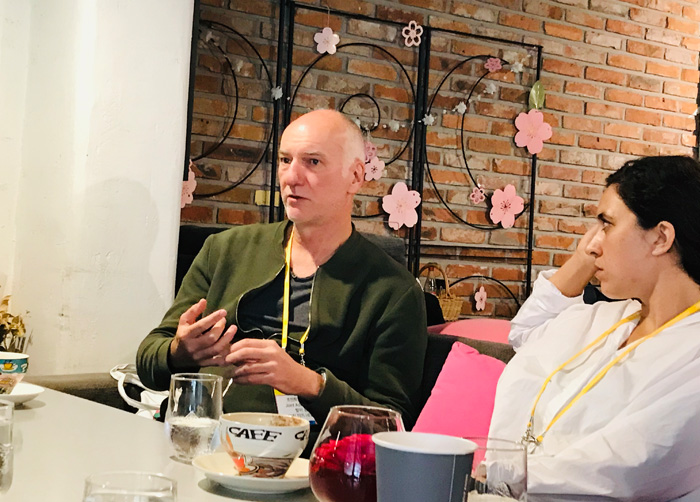
2019 PAMS Delegates Round-Table Talks / Walter Heun (Germany / Joint Adventures / Artistic Director) ⓒKAMS








 PREV
PREV
.jpg)

.jpg)
.jpg)


.jpg)
.jpg)
.jpg)
.jpg)











